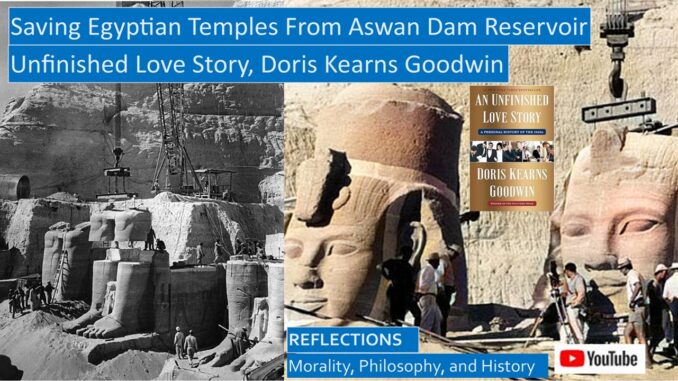
Why was the United States initially reluctant to assist in rescuing the ancient Egyptian monuments from the rising waters of the Aswan Dam reservoir?
What role did Jackie Kennedy and Richard Goodwin play in rescuing these Egyptian monuments in ancient Nubia, in modern-day Southern Egypt and Sudan?
Why is there an ancient Egyptian Temple housed in a special wing of the Metropolitan Museum of Art in New York City?
YouTube video for this reflection: https://youtu.be/FywSKdDmk88
PHARAOH RAMSES II BUILDS MAGNIFICENT MONUMENTS IN NUBIA
In the thirteenth century BC, Pharaoh Ramses II, who scholars speculate may have been the pharaoh who parleyed with Moses in Exodus, built massive monuments and temples on the banks of the Nile River in Nubia, or today’s Sudan and Southern Egypt, to impress the locals with Egyptian power and might. The Great Temple was dedicated to Ramses II himself, and the Small Temple was dedicated to his wife Nefertari, and there were numerous smaller temples.
Over time, Egyptian power waxed and waned, and the desert sands slowly buried many of these monuments after they were abandoned. By the time of the sixth century, the sand buried the massive statues of the Great Temple up to their knees. They were nearly completely buried when rediscovered by the Europeans in the 1800’s. Explorers had to dig through deep sand dunes to enter the temple.[1]
FREE OFFICER’S MOVEMENT OVERTHROWS EGYPTIAN KING
What was the history behind the building of the Aswan Dam that threatened these ancient Egyptian monuments? In the 1952 Egyptian Revolution, the Egyptian Free Officers Movement, led by Gamal Abdel Nasser and Mohamed Naguib, overthrew King Farouk in a coup d’etat, ending the British occupation of Egypt. Under a new constitution of 1956, Nasser became President of Egypt with near-dictatorial powers.[2]
Nasser, seeking to upgrade the Egyptian military, sought arms from both Russia and America. Since Israel was a client state of America, she would only supply arms for defensive purposes. The Egyptian government thought too many strings were attached to these prospective arms purchases.. Also, Egypt was ideologically closer to Russia, so Nasser decided to purchase Russian arms instead.[3]
ASWAN DAM THREATENS ANCIENT EGYPTIAN MONUMENTS
The new Egyptian regime also built the Aswan Dam in Southern Egypt, with Russian assistance, from 1960 to 1970. Historically the annual flooding of the Nile River enriched the soil of the floodplains and delta of the Nile River, making the Nile valley ideal for farming. However, low-water years meant drought and starvation, while high-water years often destroyed the whole crop. The Aswan Dam regulated the flow of water in the Nile and generated electricity for the growing population of modern Egypt.
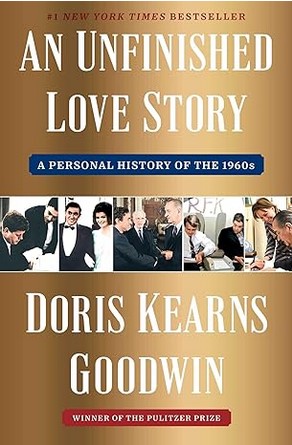
There was an International Campaign to Save the Monuments of Nubia from the flooding of the Aswan Dam reservoir. This campaign was led by the United Nations UNESCO (United Education, Scientific and Cultural Organization) from 1960 to 1980. The dam would flood close to three hundred miles south of the dam and would flood twenty-two critical historical sites.[4]
Goodwin remembers: “From the start, the entire project was entangled in Cold War politics. Angered at the Soviet Union’s participation in the Aswan Dam project, the Eisenhower administration had refused to join a UNESCO international campaign to preserve the colossal temple complex at Abu Simbel, along with dozens of smaller temples and statues. Without American leadership, combined with private philanthropy, it seemed likely that these monuments were to be forever lost beneath the lake” formed by the rising waters behind the dam.
“In 1962, Jackie Kennedy sent an urgent memo to” her husband “the president laying out the case for saving Abu Simbel: “It is the major temple of the Nile in the thirteenth century BC. It would be like letting the Parthenon to be flooded.”
Kennedy referred this project to his speechwriter and assistant, Richard Goodwin, who was also a friend and confidant of Jackie Kennedy, for prompt action. The challenge was convincing Brooklyn congressman John Rooney that the tens of millions of dollars needed would be a good expenditure. Kennedy predicted that he would reason that these were “rocks in the middle of the Egyptian desert and there’s not one Egyptian voter in the entire country.”
Jackie and Dick persuaded the government to engage in a quid pro quo swap, where the countries of the major contributors would be promised statues, vases, artifacts, and also small temples, based on the size of their contribution. Dick assembled a presentation book with photographs of both the endangered monuments and the temples available for contributors.
The pitch Dick planned to convince the congressmen to pass the funding was that “Napoleon only brought an obelisk back to Paris. We can bring back an entire temple to Washington.” Also, Jackie was busy lobbying wealthy private philanthropists to donate money to the project.
“Preserving the temple complex at Abu Simbel proved more complicated and expensive than originally conceived. The massive figures and temples had to be cut into pieces and reassembled at a higher elevation. The process had not yet begun by the time Kennedy died. It was left to President Johnson to secure the necessary additional funds.”
THE TEMPLE OF DENDUR IN METROPOLITAN MUSEUM OF ART
Museums in the United States, France, Germany, Spain, and the Netherlands were gifted minor ancient Egyptian temples in exchange for their countries’ assistance in saving these ancient Egyptian monuments. Since the Abu Simbel Temple was on the banks of the Nile, it is built into a small pool in the Metropolitan Museum.
Goodwin recalls: “Once the money had been appropriated, Jackie and Dick were able to select a temple commensurate to the public and private money they had amassed. They consulted a group of Egyptologists and narrowed the choices. In the end, both wanted the Temple of Dendur, built to honor the Egyptian goddess Isis by the Roman governor of Egypt, Augustus Caesar, around 15 BC. With a walkway that led to the banks of the Nile, this temple seemed perfectly suited for the banks of the Potomac” alongside the cherry blossoms of Washington, DC.
Goodwin continues: “Instead of being reassembled on the banks of the Potomac as a memorial tribute to John Kennedy as Jackie would have preferred, the Temple was encased in a specially constructed glass wing at the Metropolitan Museum of Art in New York City. In a controlled atmosphere to prevent erosion, a sandstone pylon opens onto a small courtyard where, after unimaginable travels of six thousand miles and nearly two thousand years, rises the exquisite Nubian Temple of Dendur.” It cost nearly ten million dollars to move the Temple of Dendur to New York City.
The Temple of Dendur was submerged for part of the year in Egypt after the first Aswan Dam was built around 1900.[5] The Metropolitan Museum of Art has many other ancient Egyptian artifacts, including a statue of the major Egyptian bird-god Horus, he was the god of kingship, healing, protection, the sun, and the sky.[6] The model boat was likely placed in a royal Egyptian tomb, these figurines would revive in the afterlife to serve the pharaoh.[7] In Egyptian mythology, a sphinx usually depicts a pharaoh, emphasizing his strength and ferocity.[8]
DISCUSSING THE SOURCES
In An Unfinished Love Story, Doris Kearns Goodwin remembers the role her late husband Richard Goodwin and Jackie Kennedy played in facilitating the American efforts to save the ancient Nubian monuments from the rising waters of the Aswan Dam reservoir. We discuss this source in greater length in our reflections on John Kennedy and Lyndon Johnson.
John F Kennedy, Cuba, Russia, and Civil Rights, Book Review of An Unfinished Love Story
https://seekingvirtueandwisdom.com/john-f-kennedy-cuba-russia-and-civil-rights-review-of-an-unfinished-love-story/
https://youtu.be/krkJki2vQ2o
Lyndon Johnson, Enacting the Great Society and Vietnam, Review of an Unfinished Love Story
https://seekingvirtueandwisdom.com/lyndon-johnson-enacting-the-great-society-and-vietnam-review-of-an-unfinished-love-story/
https://youtu.be/MgVEipHdvfM
The Wikipedia article on the International Campaign to Save the Monuments of Nubia includes links to the original UNESCO magazine’s articles detailing this amazing rescue effort, several of the UNESCO photos were used in this reflection.
[1] https://en.wikipedia.org/wiki/Abu_Simbel
[2] https://en.wikipedia.org/wiki/1952_Egyptian_revolution
[3] https://en.wikipedia.org/wiki/Gamal_Abdel_Nasser
[4] https://en.wikipedia.org/wiki/Aswan_Dam and https://en.wikipedia.org/wiki/International_Campaign_to_Save_the_Monuments_of_Nubia
[5] Doris Kearns Goodwin, An Unfinished Love Story (New York: Simon and Schuster, 2024), Chapter 5, The Supreme Generalist, pp. 117-120 and https://en.wikipedia.org/wiki/Temple_of_Dendur and https://en.wikipedia.org/wiki/International_Campaign_to_Save_the_Monuments_of_Nubia
[6] https://en.wikipedia.org/wiki/Horus
[7] https://en.wikipedia.org/wiki/Ancient_Egyptian_funerary_practices

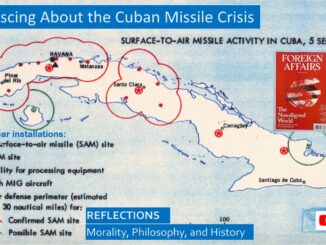
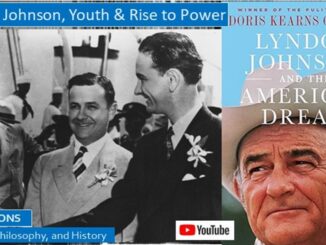
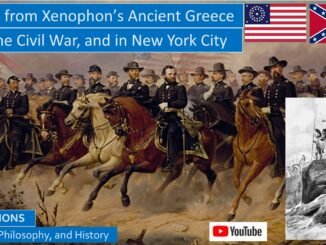
1 Trackback / Pingback